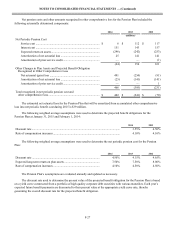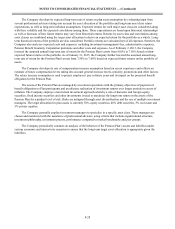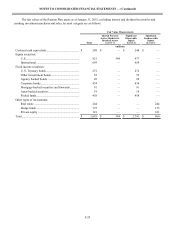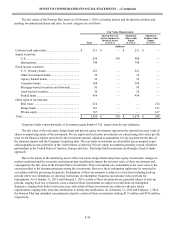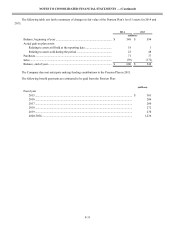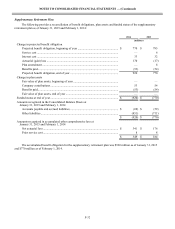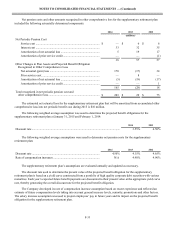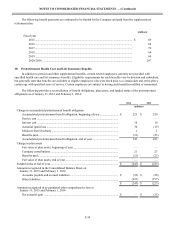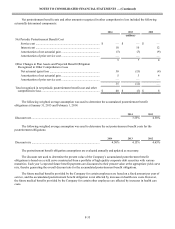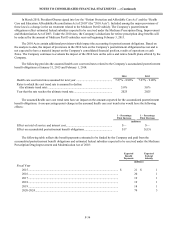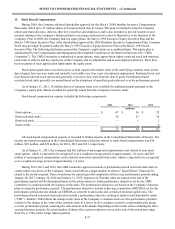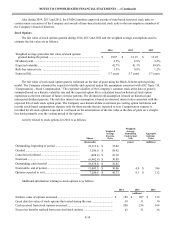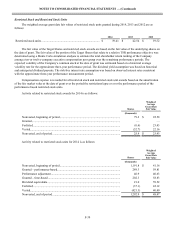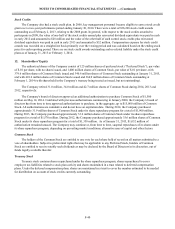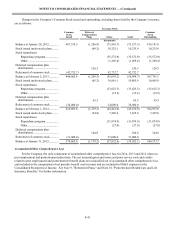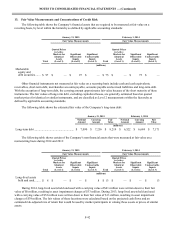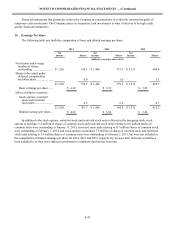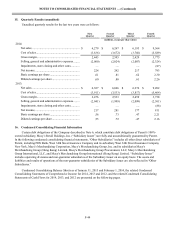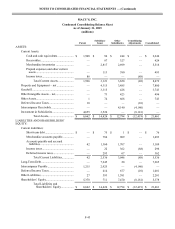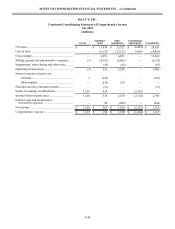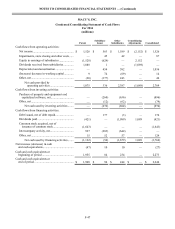Macy's 2014 Annual Report Download - page 84
Download and view the complete annual report
Please find page 84 of the 2014 Macy's annual report below. You can navigate through the pages in the report by either clicking on the pages listed below, or by using the keyword search tool below to find specific information within the annual report.
NOTES TO CONSOLIDATED FINANCIAL STATEMENTS — (Continued)
F-37
11. Stock Based Compensation
During 2009, the Company obtained shareholder approval for the Macy’s 2009 Omnibus Incentive Compensation
Plan under which up to 51 million shares of Common Stock may be issued. This plan is intended to help the Company
attract and retain directors, officers, other key executives and employees and is also intended to provide incentives and
rewards relating to the Company’s business plans to encourage such persons to devote themselves to the business of the
Company. Prior to 2009, the Company had two equity plans; the Macy's 1995 Executive Equity Incentive Plan and the
Macy's 1994 Stock Incentive Plan. After shareholders approved the 2009 Omnibus Incentive Compensation Plan, Common
Stock may no longer be granted under the Macy's 1995 Executive Equity Incentive Plan or the Macy's 1994 Stock
Incentive Plan. The following disclosures present the Company’s equity plans on a combined basis. The equity plan is
administered by the Compensation and Management Development Committee of the Board of Directors (the “CMD
Committee”). The CMD Committee is authorized to grant options, stock appreciation rights, restricted stock and restricted
stock units to officers and key employees of the Company and its subsidiaries and to non-employee directors. There have
been no grants of stock appreciation rights under the equity plans.
Stock option grants have an exercise price at least equal to the market value of the underlying common stock on the
date of grant, have ten-year terms and typically vest ratably over four years of continued employment. Restricted stock and
time-based restricted stock unit awards generally vest one to four years from the date of grant. Performance-based
restricted stock units generally are earned based on the attainment of specified goals achieved over the performance period.
As of January 31, 2015, 24 million shares of common stock were available for additional grants pursuant to the
Company’s equity plan. Shares awarded are generally issued from the Company's treasury stock.
Stock-based compensation expense included the following components:
2014 2013 2012
(millions)
Stock options............................................................................................ $ 47 $ 36 $ 28
Restricted stock units ............................................................................... 26 25 26
Restricted stock ........................................................................................ — 1 1
Stock credits............................................................................................. — — 6
$ 73 $ 62 $ 61
All stock-based compensation expense is recorded in SG&A expense in the Consolidated Statements of Income. The
income tax benefit recognized in the Consolidated Statements of Income related to stock-based compensation was $26
million, $22 million, and $22 million, for 2014, 2013 and 2012, respectively.
As of January 31, 2015, the Company had $62 million of unrecognized compensation costs related to nonvested
stock options, which is expected to be recognized over a weighted average period of approximately 1.8 years, and $29
million of unrecognized compensation costs related to nonvested restricted stock units, which is expected to be recognized
over a weighted average period of approximately 1.4 years.
During 2014, 2013 and 2012, the CMD Committee approved awards of performance-based restricted stock units to
certain senior executives of the Company. Each award reflects a target number of shares (“Target Shares”) that may be
issued to the award recipient. These awards may be earned upon the completion of three-year performance periods ending
January 28, 2017, January 30, 2016 and January 31, 2015, respectively. Whether units are earned at the end of the
performance period will be determined based on the achievement of certain performance objectives set by the CMD
Committee in connection with the issuance of the units. The performance objectives are based on the Company’s business
plan covering the performance period. The performance objectives include achieving a cumulative EBITDA level for the
performance period and also include an EBITDA as a percent to sales ratio and a return on invested capital ratio. The
performance-based restricted stock units also include a performance objective relating to relative total shareholder return
(“TSR”). Relative TSR reflects the change in the value of the Company’s common stock over the performance period in
relation to the change in the value of the common stock of a ten-or twelve-company executive compensation peer group
over the performance period, assuming the reinvestment of dividends. Depending on the results achieved during the three-
year performance periods, the actual number of shares that a grant recipient receives at the end of the period may range
from 0% to 150% of the Target Shares granted.


